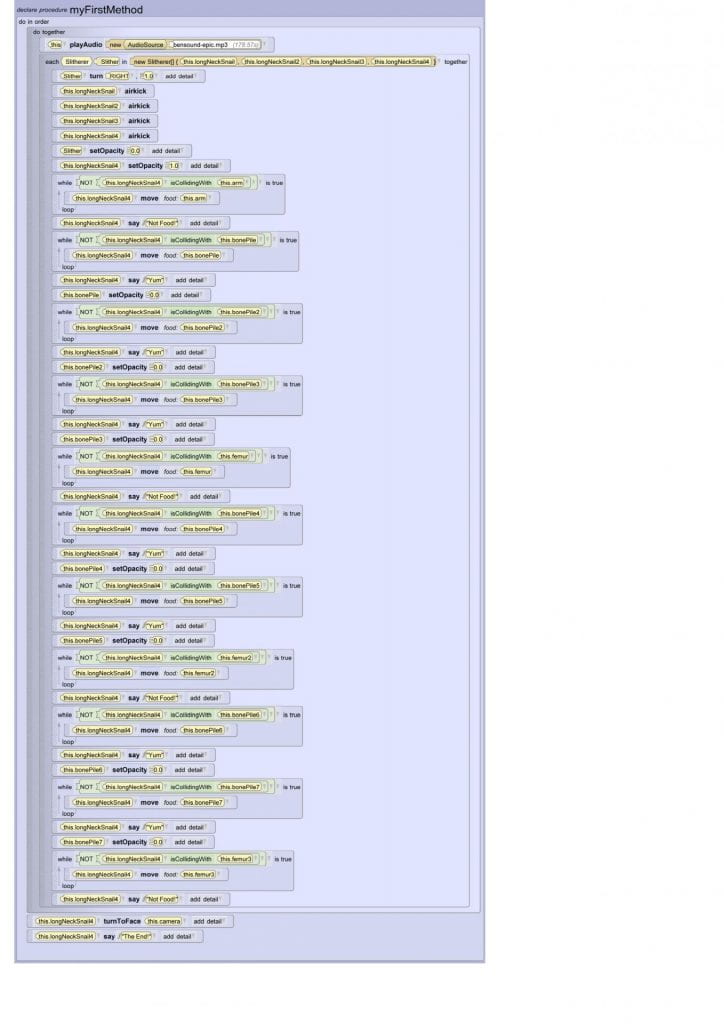
My partner Isaiah and I made this project as our semester exam. It puts two spoopy racers against each other in a race to the finish. You can select your music and camera angle during the race, which adds some variety to the race.

My partner Isaiah and I made this project as our semester exam. It puts two spoopy racers against each other in a race to the finish. You can select your music and camera angle during the race, which adds some variety to the race.
Race of the races: aliens vs humans final showdown begins! Enjoy!
From, Xavier and Scottie
In this program, there are two outcomes; one of them will escape whilst the other one gets caught.
Ben and I have worked hard on this project. After a few minor setbacks we finally finished. Hope you enjoy it.
This program has two possible endings – either car can win.
Pair programming is a technique advocated by Code.org as well as others to support the development and review of coding. It is sometimes used in recruitment interviews. In this example, students are triplet programming but still demonstrating and practicing essential skills for problem solving, sharing roles as navigators and drivers, and sharing their thinking. Pair programming builds social skills and promotes learning as student rely on each other.
These students are working on an Alice 3 project that requires creating and using random numbers, making decisions using if statements, using repetitions and loops.

Learn more at
https://medium.com/@weblab_tech/pair-programming-guide-a76ca43ff389
While making this game I learned how to use collision events and how to make multiple levels in a game.
This game was created using Alice 3 software. When the game is run the yeti will start moving and you will have to catch them all within 40 seconds during level 1. During level 2 a random amount of yeti will turn red and a random amount of yeti will turn blue. The blue yeti will give 2 points while the red yeti will take away 1 point. The white yeti still give 1 point. The goal is to get 7 or more points within the 40 second time-frame. During the final level some ostriches are added that if collided with will make you be reset to your starting position. The goal in level 3 is the same as in level 2. Before each level a prompt will come up asking if you want instructions.
This is an example of an Alice 3 project in week 5 of the progression where we learn how to make and call functions in code. The wolf compares heights of the animals and jumps over whoever is tallest.



This is part of my code where I met the lesson objectives to make a function and understand how they return information. In my code, the function ‘tallestHeight’ returns the tallest creature of two and is used to make the wolf tell us how tall the tallest animal is.
I took the Lesson 5.1 project and changed it up a bit. First off by making the different animals into a group of snails, and changing the fruit and emeralds in the area into skeletons and femurs. While the appearance has changed what the snails do is the same as the 5.1 project. From moving to each object in the scene finding out what is food and what isn’t, and preforming a quick dance with his snail friends.

This is the main function so it doesn’t include what the procedures do, but does give a good understanding of how the snail knows what is food and what isn’t food. The two functions that are used are called airkick and move the airkick is seen at the beginning when the snails go up into the are and kick. While the move tells the snail where to face, where to go, and how to move its body forward and backward while moving. Then I have implemented a array that groups all the snails into one object that I can manipulate. This is shown when all the snails change to opacity 0 together. Which is done with one instruction of change opacity to 0 instead of 4 thanks to the slither array.

Alice 3 uses object oriented programming to build stories and games while teaching programming and animation. Created by Randy Pausch and his collaborative team, with roots in building virtual worlds, Alice 3 continues to be developed and provided by the Entertainment Technology Center at Carnegie Mellon University.
Students in JRTI Studios are studying Alice 3 using a new online course created and piloted by Duke University and distributed through Coursera. Dr. Susan Rodger, professor computer science at Duke University and Dr. Stephen Cooper, professor of computer science at the University of Nebraska-Lincoln, are the instructors. The 8 units guide students through a progression from setting up objects and scenes to the development of their own adventure game.